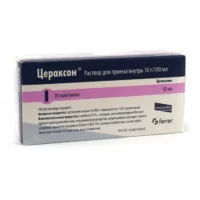Description
Domperidon-Stoma (Domperidone) Tablets 0.01g. №30
Ingredients
Active ingredient: Domperidone 0.01g per tablet.
Mechanism of Action
Domperidone, the active ingredient in Domperidon-Stoma tablets, is a dopamine antagonist that acts on the chemoreceptor trigger zone in the brain. By blocking dopamine receptors, it exerts antiemetic effects, helping to alleviate symptoms of nausea and vomiting.
Pharmacological Properties
Pharmacological Effects: Domperidone works by blocking dopamine receptors in the brain and gut. This action increases the motility of the stomach and intestines, thereby reducing symptoms of nausea and vomiting.
Indications for Use
Indications: Domperidon-Stoma tablets are indicated for the relief of symptoms of nausea and vomiting.
Contraindications
Contraindications: Do not use Domperidon-Stoma tablets if you have a known hypersensitivity to domperidone or any of the excipients.
Side Effects
Common side effects of Domperidon-Stoma tablets may include headache, dizziness, dry mouth, and gastrointestinal disturbances. If you experience any severe side effects, contact your healthcare provider immediately.
Usage Instructions
Dosage: The usual dose for adults is 10mg (1 tablet) taken 3 to 4 times a day before meals and at bedtime. Take the tablets orally with a glass of water. Do not crush or chew the tablets. Follow the dosage instructions provided by your healthcare provider.
Benefits Compared to Analogues
Domperidone has been shown to be effective in the treatment of nausea and vomiting, especially in conditions such as gastroparesis and functional dyspepsia. Its favorable side effect profile and established efficacy make it a preferred choice over other antiemetic agents.
Suitable Patient Groups
Domperidon-Stoma tablets are suitable for adults experiencing symptoms of nausea and vomiting. It is important to consult a healthcare professional before administering this medication to children, the elderly, or individuals with specific medical conditions to determine the appropriate dosage and suitability.
Storage and Shelf Life
Store Domperidon-Stoma tablets in a cool, dry place away from direct sunlight. Keep the tablets in their original packaging to protect them from moisture. Check the expiration date on the packaging and do not use the tablets if expired.
Packaging Description
Domperidon-Stoma tablets are available in a package containing 30 tablets. Each tablet is formulated to contain 0.01g of Domperidone as the active ingredient.
Clinical Evidence and Proven Effectiveness
Clinical studies have shown that Domperidone is effective in the treatment of nausea and vomiting, particularly in conditions like gastroparesis and functional dyspepsia. Research published in reputable journals has demonstrated the superior efficacy of Domperidone over a placebo in reducing symptoms of gastroparesis and improving functional dyspepsia compared to baseline.





